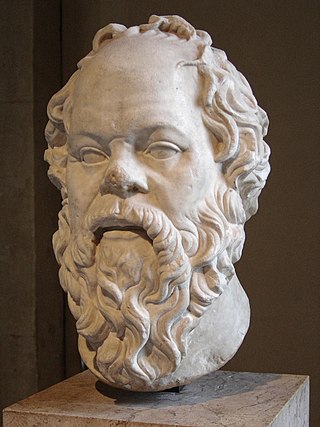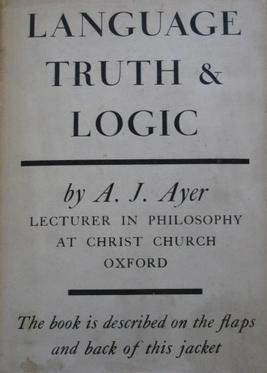Third logical qualities
Logicians in the western traditions have often expressed belief in some other logical quality besides affirmation and denial. Sextus Empiricus, in the 2nd or 3rd century CE, argued for the existence of "nonassertive" statements, which indicate suspension of judgment by refusing to affirm or deny anything. [4] Pseudo-Dionysius the Areopagite in the 6th century, argued for the existence of "non-privatives", which transcend both affirmation and denial. For example, it is not quite correct to affirm that God is, nor to deny that God moves, but rather one should say that God is beyond-motion, or super-motive, and this is intended not just as a special kind of affirmation or denial, but a third move besides affirmation and denial. [5]
For Kant every judgment takes one of three possible logical qualities, Affirmative, Negative or Infinite. For Kant, if I say “The soul is mortal” I have made an affirmation about the soul; I have said something contentful about it. If I say “The soul is not mortal,” I have made a negative judgment and thus “warded off error” but I have not said what the soul is instead. If, however, I say “The soul is non-mortal,” I have made an infinite judgment. For the purposes of “General logic” it is sufficient to see infinite judgments as a sub-variety of affirmative judgments, I have said something of the soul, namely that it is not mortal. But from the standpoint of “Transcendental Logic” it is important to distinguish the infinite from the affirmative. Although I have taken something away from the possibilities of what the soul might be like, I have not thereby said what it is or clarified the concept of the soul, there are still an infinite number of possible ways the soul could be. The content of an infinite judgment is purely limitative of our knowledge rather than ampliative of it. [6] Hegel follows Kant in insisting that, at least transcendentally, affirmation and negation are not enough but require a third logical quality sublating them both. [7]
In ontology, the theory of categories concerns itself with the categories of being: the highest genera or kinds of entities according to Amie Thomasson. To investigate the categories of being, or simply categories, is to determine the most fundamental and the broadest classes of entities. A distinction between such categories, in making the categories or applying them, is called an ontological distinction. Various systems of categories have been proposed, they often include categories for substances, properties, relations, states of affairs or events. A representative question within the theory of categories might articulate itself, for example, in a query like, "Are universals prior to particulars?"
In logic, the law of non-contradiction (LNC) states that contradictory propositions cannot both be true in the same sense at the same time, e. g. the two propositions "p is the case" and "p is not the case" are mutually exclusive. Formally, this is expressed as the tautology ¬(p ∧ ¬p). The law is not to be confused with the law of excluded middle which states that at least one, "p is the case" or "p is not the case", holds.
In logic, the law of excluded middle states that for every proposition, either this proposition or its negation is true. It is one of the so-called three laws of thought, along with the law of noncontradiction, and the law of identity. However, no system of logic is built on just these laws, and none of these laws provides inference rules, such as modus ponens or De Morgan's laws.
Truth or verity is the property of being in accord with fact or reality. In everyday language, truth is typically ascribed to things that aim to represent reality or otherwise correspond to it, such as beliefs, propositions, and declarative sentences.

A syllogism is a kind of logical argument that applies deductive reasoning to arrive at a conclusion based on two propositions that are asserted or assumed to be true.
Dialectic, also known as the dialectical method, refers originally to dialogue between people holding different points of view about a subject but wishing to arrive at the truth through reasoned argumentation. Dialectic resembles debate, but the concept excludes subjective elements such as emotional appeal and rhetoric. It has its origins in ancient philosophy and continued to be developed in the Middle Ages.
The history of logic deals with the study of the development of the science of valid inference (logic). Formal logics developed in ancient times in India, China, and Greece. Greek methods, particularly Aristotelian logic as found in the Organon, found wide application and acceptance in Western science and mathematics for millennia. The Stoics, especially Chrysippus, began the development of predicate logic.

In term logic, the square of opposition is a diagram representing the relations between the four basic categorical propositions. The origin of the square can be traced back to Aristotle's tractate On Interpretation and its distinction between two oppositions: contradiction and contrariety. However, Aristotle did not draw any diagram; this was done several centuries later by Apuleius and Boethius.
In logic and formal semantics, term logic, also known as traditional logic, syllogistic logic or Aristotelian logic, is a loose name for an approach to formal logic that began with Aristotle and was developed further in ancient history mostly by his followers, the Peripatetics. It was revived after the third century CE by Porphyry's Isagoge.

The Critique of Pure Reason is a book by the German philosopher Immanuel Kant, in which the author seeks to determine the limits and scope of metaphysics. Also referred to as Kant's "First Critique", it was followed by his Critique of Practical Reason (1788) and Critique of Judgment (1790). In the preface to the first edition, Kant explains that by a "critique of pure reason" he means a critique "of the faculty of reason in general, in respect of all knowledge after which it may strive independently of all experience" and that he aims to reach a decision about "the possibility or impossibility of metaphysics". The term "critique" is understood to mean a systematic analysis in this context, rather than the colloquial sense of the term.
Dialetheism is the view that there are statements that are both true and false. More precisely, it is the belief that there can be a true statement whose negation is also true. Such statements are called "true contradictions", dialetheia, or nondualisms.

Science of Logic, first published between 1812 and 1816, is the work in which Georg Wilhelm Friedrich Hegel outlined his vision of logic. Hegel's logic is a system of dialectics, i.e., a dialectical metaphysics: it is a development of the principle that thought and being constitute a single and active unity. Science of Logic also incorporates the traditional Aristotelian syllogism: it is conceived as a phase of the "original unity of thought and being" rather than as a detached, formal instrument of inference.
De Interpretatione or On Interpretation is the second text from Aristotle's Organon and is among the earliest surviving philosophical works in the Western tradition to deal with the relationship between language and logic in a comprehensive, explicit, and formal way. The work is usually known by its Latin title.
"Critique of the Kantian philosophy" is a criticism Arthur Schopenhauer appended to the first volume of his The World as Will and Representation (1818). He wanted to show Immanuel Kant's errors so that Kant's merits would be appreciated and his achievements furthered.
The history of logic as a subject has been characterised by many disputes over what the topic deals with, and the main article 'Logic' has as a result been hesitant to commit to a particular definition of logic. This article surveys various definitions of the subject that have appeared over the centuries through to modern times, and puts them in context as reflecting rival conceptions of the subject.

Language, Truth and Logic is a 1936 book about meaning by the philosopher Alfred Jules Ayer, in which the author defines, explains, and argues for the verification principle of logical positivism, sometimes referred to as the criterion of significance or criterion of meaning. Ayer explains how the principle of verifiability may be applied to the problems of philosophy. Language, Truth and Logic brought some of the ideas of the Vienna Circle and the logical empiricists to the attention of the English-speaking world.
The False Subtlety of the Four Syllogistic Figures Proved is an essay published by Immanuel Kant in 1762.

In Immanuel Kant's philosophy, a category is a pure concept of the understanding (Verstand). A Kantian category is a characteristic of the appearance of any object in general, before it has been experienced. Following Aristotle, Kant uses the term categories to describe the "pure concepts of the understanding, which apply to objects of intuition in general a priori…" Kant further wrote about the categories: "They are concepts of an object in general, by means of which its intuition is regarded as determined with regard to one of the logical functions for judgments." The categories are the condition of the possibility of objects in general, that is, objects as such, any and all objects, not specific objects in particular. Kant enumerated twelve distinct but thematically related categories.
Connexive logic names one class of alternative, or non-classical, logics designed to exclude the paradoxes of material implication. The characteristic that separates connexive logic from other non-classical logics is its acceptance of Aristotle's thesis, i.e. the formula,

In logic, reductio ad absurdum, also known as argumentum ad absurdum or apagogical arguments, is the form of argument that attempts to establish a claim by showing that the opposite scenario would lead to absurdity or contradiction.






